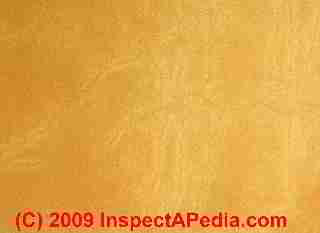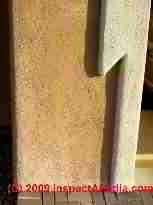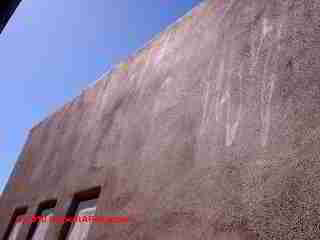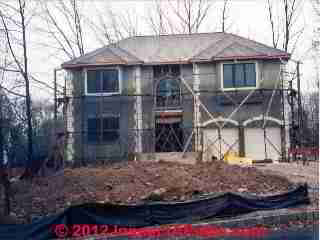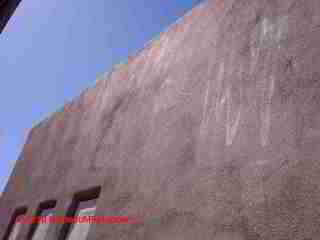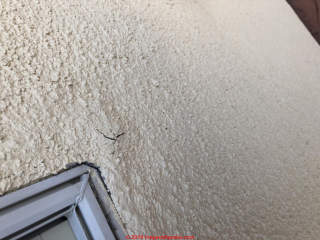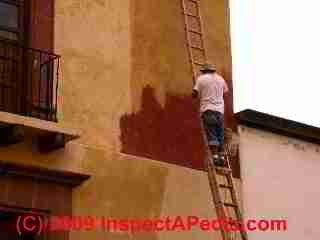 Causes of Paint Failures on Stucco Exterior Walls
Causes of Paint Failures on Stucco Exterior Walls
- POST a QUESTION or COMMENT about diagnosing paint problems on exterior or interior stucco building surfaces
Paint failures on stucco walls, cause, diagnosis, cure & prevention methods:
This article describes common building exterior & interior painting mistakes when painting on modern stucco building exteriors, describes how to diagnose paint failures on buildings, and outlines a procedure for diagnostic field inspection & lab testing of failed painted surfaces.
We discuss the following: Stucco Paint Failure Indicator,s Stucco exterior cracks, white deposits, stains, efflorescence causes - Causes of white efflorescence bloom on stucco building walls. Stucco pH & Stucco Paint Failure How do stucco pH and moisture impact the success of a stucco paint job?
Water & Weather & Painted Stucco. Avoiding Paint Failure on New Stucco What is saponification and how does it cause paint adhesion and cracking failures? Correcting Paint Failures When Re-Painting.
InspectAPedia tolerates no conflicts of interest. We have no relationship with advertisers, products, or services discussed at this website.
- Daniel Friedman, Publisher/Editor/Author - See WHO ARE WE?
Stucco Wall Paint Failure Indicators: These Paint Failure Indicators Help Diagnose Paint Problems on Stucco
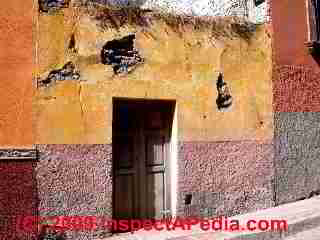
The combination of cost and schedule pressures and lack of information about the cause of stucco paint job failures may lead some painting contractors into trouble, especially at new construction sites.
[Click to enlarge any image]
The combination of high lime stucco, schedule and cost pressures, and failure to appreciate the importance of stucco hydration and curing prior to painting lead to stucco cracks, white blooms of efflorescence salts in some areas of the stuccoed surface, and early paint job failure - sometimes in less than a year after painting.
Her we include photographs of paint failures on buildings and more photos of forensic paint laboratory examination of samples of failed paint useful to assist in diagnosing the probable cause of each type of paint failure.
The diagnosis and cure of paint failure on buildings, particularly on wood siding and trim, is quite possible if there is a careful and thorough inspection of the building, its history, its surfaces, and the actual points of paint failure.
It is diagnostic to compare the same coating on the same type of surface at different locations on a building and in areas of failed and not-failed paint.
Typical field investigation of paint failures on stucco exteriors involves recording the pattern and extent of paint failure on all building surfaces, possibly correlating paint failures to different building sun or weather exposures, measuring the moisture content of the stucco (of course this may not directly indicate what the moisture content was at the time of paint application), chemical testing of paint and stucco samples, and knife probing or parallel razor cuts and tape testing to assess the adhesion characteristics of the painted coating.
Typical causes of or contributors to paint failure on stucco exteriors and other information that we consider when diagnosing paint failure on stucco include the following paint failure causes and signs
- Painting over un-sound stucco or on even a brand new stucco wall that has not been properly prepared and cured. See our photo of antique stucco on an adobe home wall just above. Also see ADOBE CONSTRUCTION
- Stucco wall cracking that maps most color changes and efflorescence found together on a building often indicate insufficient hydration during stucco curing and failure to seal the cracks with an elastomeric stucco patch compound prior to painting.
- Failure to sufficiently hydrate the stucco during curing, especially in hot windy climates. Hydration, wetting down the stucco extracts the high levels of lime that are often present to provide workability of the stucco coating during application on the building.
- Rushing the stucco paint job: because the contractor may want to use the scaffolding that was set up to apply the stucco, the painting contractor may be tempted to paint before the stucco was adequately cured.
Painting over stucco that is inadequately cured (high pH) or still wet (high moisture) can lead to a saponification failure, especially at locations where subsequent leaks or water wet the stucco substrate.
See STUCCO PAINT SAPONIFICATION & ADHESION FAILURES below. - Surface conditions of the stucco at time of painting - cure of the stucco, pH, cracks, moisture level, temperature, wind, sun exposure, even dirt or dust
- Method of application of paint coatings on stucco, spray or roll-on of the paint for primer and top coat, including also the number of coats applied.
- Paint selection for use on stucco: compatibility between primer and top coat, compatibility with new stucco, whether a primer was really applied, whether the paint was thinned excessively or was otherwise defective or even intended for this application.
The paint product(s) that have been used should have been selected and applied according to their manufacturer-recommended application methods - Paint company and paint industry standards for painting stucco and recommendations for painting over stucco need to be respected
- Stucco wall moisture level and stucco wall pH measurements made by the painter during the painting process - were they made at all and were they made properly?
- History of the stucco surface paint job, the dates of stucco application, date of painting, weather conditions may indicate a rush job or special rain, sun, wind, or freezing exposure weather problems that ruined the paint job before it had a chance to dry and cure.
- Comments by other onsite investigators and their reports, if any, can provide important diagnostic details
- Proposals for remediation/repair re-painting work on a stucco paint failure necessary at the property, if any, can also provide important diagnostic details
Stucco Paint Saponification Adhesion Failures
Saponification of the paint binder - adhesion loss on painted stucco: saponification at the contact point of paint on a stucco surface: saponification refers to a process also called alkaline hydrolysis: water and high alkalinity breaks an ester [a class of organic compounds that react with water to produce an alcohol and an acid] down to a carboxylic acid [an organic acid -COOH or -CO2H, typically a weak acid] and an alcohol.
See RUSHING the STUCCO PAINT JOB
If the pH of the STUCCO SURFACE continues at an alkaline level, which often happens when raw stucco is painted-over too soon, carboxylic acid will be be detected as carboxylic acid salt - (a carboxylate anion with metal cation, such as Na or Ca. Saponification weakens the paint film adhesion at the surface of the stucco.
Water or PAINTING on WET STUCCO combined with high pH is what creates a saponification-adhesion-loss problem on stucco and can also cause hairline cracks in the stucco coating.
Here is a more technically detailed explanation of the stucco saponification adhesion failure problem, with editing by DF:
Saponification not only affects paint adhesion. the acrylic film becomes rigid, possibly leading to hairline cracks in the stucco coating.
Exposure to the alkaline solution from the stucco forms a hydrophilic [water resistant] layer of low molecular weight calcium soap beneath the [paint] film that attracts additional water and causes the saponification to spread.
Ultimately, the chemical "anchor" [holding the paint onto the stucco surface] is removed from the film which results in diminished adhesion. A paint saponification failure mechanism can be further supported by the location of the failures on the building. Look for specific locations of paint adhesion failure, contrasted with a more uniform paint adhesion failure over all of the structure, on all sides and locations.
Disbonding [breaking the paint-to-surface bond] is generally observed only in areas exposed to water permeation through unscheduled openings in the structure [such as leaks at poorly-sealed trim or at penetrations added for fixtures].
In a saponification failure of a painted stucco surface, most of the surface area sealed by the coating and not exposed to water will be found soundly adhered with no signs of deterioration.
Water permeation of the stucco substrate at ledges, mortar joints, edges of balconies, and areas near the ground which were wetted by capillary action, cause the alkaline salts in the stucco to be leeched into the water, resulting in a stucco paint saponification failure. - KTA Tator, referred to InspectAPedia by conservator Ulrik Runeberg
Details area at PAINT ANALYSIS USES.
Definitions of esther and carboxylic acid - Princeton University.
Stucco pH as Contributor to Paint Failure
When painting on stucco, the pH (alkalinity) of the surface as well as moisture trapped under paint have been associated with efflorescence or white blooming problems.
Field test of stucco pH: A simple field test can measure the alkalinity of the stucco: A small sample of the stucco is removed from the building, powdered and added to an equal volume of distilled water.
Watch out: Do not use tap water. If the measured electrical resistance in the solution is low, and if the chloride concentration is high there is a considerable level of chloride-based electrolyte in the sample.
Measure the pH of the sample. If it is high ( pH was 11) the stucco sample is very alkaline - a neutral pH is 6-7 range.
White powdery blotches appearing in the painted stucco surface are usually blooms of efflorescence caused by painting over cracks or other areas of extra moisture absorption in the stucco surface.
Where recently-applied stucco was not adequately cured, and where surface alkalinity remained too high (pH over 11) white efflorescence blooms are particularly common. This painting error, sometimes the fault of rushing the paint job, leads to both cosmetic defects and early paint failure.
While a painter reports having taken some pH measurements with acceptable results, our field work has consistently found that both moisture and pH vary significantly over a building surface.
When relying on measurements (and thus rushing the paint job schedule or painting “early”) rather than allowing more elapsed time in deciding when to paint a building, a common error is to rely on “safe” readings obtained in some areas while failing to measure or attend unacceptable moisture or pH level readings in other building areas.
If on a building the stucco was applied in very hot dry conditions (no surprise in Arizona, for example) and was if the stucco inadequately wet down (hydrated) during cure, that could also have left areas of high pH, making the pH measurements we cited above critical when deciding when to paint or whether additional surface preparation was needed.
See the stucco painting advice articles we cite at References below.
Efflorescence on building surfaces, including on a painted stucco surface is described at Efflorescence & white or brown deposits.
Water & Weather Impact on Inspection of Painted Stucco Surfaces
Water or wet stucco combined with high pH is the problem. It is the combination of painting over a still-wet stucco surface or still damp surface, or a surface that is subsequently exposed to abnormal wetting, along with high alkalinity that causes saponification of an acrylic paint on stucco.
When painting a sufficiently dry stucco surface, alkalinity alone will not cause this problem. - paraphrased from KTA Tator, a Pittsburgh consulting firm.
As our photos demonstrate, the appearance of any painted surface, particularly new stucco, can be significantly different when it is wet.
While there is nothing abnormal or "wrong" with a painted surface that looks a bit different when wet, say darker in color, streaks or the appearance of mottled efflorescence or white blooms on a wall after wetting may be telltales of a paint problem, and certainly these inconsistencies mean that a paint failure investigator needs to inspect when the surface is dry.
Inspecting in the rain or just after raining or other sources of wet on a building exterior may lead to incorrect conclusions.
White Run-Down Stains on Exterior Stucco after New Paint Job
Below we show several photographs of ugly white stains that appeared quickly after a reader's home's stucco exterior was spray painted in 2010. The reader indicated that the painters applied a Dunn-Edwards exterior flat acrylic paint very quickly, perhaps too quickly, after the home had been power-washed.
The stains are most likely not due to a defect in the paint itself (unless it was amended or over-thinned by the painter) and more likely due to improper surface preparation combined with painting before the surface was dry after power washing.
As detailed at STUCCO WALL METHODS & INSTALLATION and also in the printed text Best Practices Guide to Residential Construction (Steve Bliss, J Wiley & Sons) :
The Importance of Weather to Stucco Work and Stucco Paint Coatings
See details about the cause, diagnosis, cure, or prevention of paint failures on stucco exterior walls, found at
Moisture, humidity, rain, or wet conditions during thin-coat or EIFS stucco work can lead to a subsequent series of failures of the entire installation.
The home shown in our photo above was the subject of litigation. We observed that the final stucco had been applied over wet surfaces and in some cases over surfaces that also had been troubled by soil that had splashed-up on the building during rainy weather.
White blooms and stains in stucco paint jobs may be due to painting when the surfaces were too dampe or painting when the paint would be exposed to cool or cold temperatures or dampness, dew, rain, before the paint was cured.
See PAINT FAILURE SURFACTANT LEACHING for details.
Stucco wall paint failures are also traced to moisture, efflorescence, and failure to adequately clean the exterior and then allow it to dry before painting.
See also PAINTING in SUN or WIND.
Temperature during stucco work will speed up or slow down the hydration process that cures the cement in stucco.
It is best to avoid application in extremely hot or cold temperatures. In hot, dry, and windy weather, frequent misting will be required on the scratch coat or the installer may need to tape polyethylene sheeting in place for proper curing.
Direct sun tends to dry out the fresh stucco too fast, so installers should try to follow the shade around the building. Also, retardants are available that can be sprayed on the scratch or brown coat in hot weather to slow down the curing.
Sun, heat, and rapid drying conditions can present special stucco application troubles or subsequent stucco paint coating troubles in hot dry climates such as the American Southwest. (Photo at left).
Cold weather also presents problems. Stucco should not be applied under 40°F, and it should not be allowed to freeze within 24 hours of application. Accelerators can be added to the stucco mix in cold weather, but these can weaken the material, and calcium-based accelerators can lead to efflorescence.
Heating the materials and, if necessary, tenting the structure can permit work to proceed in cold, even freezing, weather.
Cool, moist weather is ideal for traditional stucco wall installations. In humid weather, with relative humidity over 70% or heavy fog, misting is not usually required.
Tips for Avoiding Paint Failure on New Stucco Exteriors
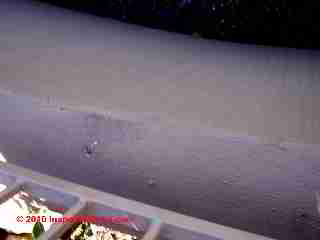 Our best guess is that the run-stains down this newly painted stucco wall (photo at left) as well as the stains above are consistent with wet areas in the stucco and uneven drying following power washing.
Our best guess is that the run-stains down this newly painted stucco wall (photo at left) as well as the stains above are consistent with wet areas in the stucco and uneven drying following power washing.
- Hydrate the stucco: Be sure that the stucco is adequately hydrated during curing.
Washing down the stucco in hot dry climates and keeping it hydrated avoids cracking and the development of white efflorescence blooms on the building surface.
Typically in hot or windy conditions the new stucco is hydrated by the stucco contractor for two or three days to slow the stucco curing rate and to permit the chemistry of stucco curing to complete to a sufficiently hard and impermeable surface. - Be sure that the stucco has adequately cured before painting. Typically the stucco must cure for at least ten days to two weeks before it can be painted. The pH of cured stucco is normally below 11. If the stucco is still "hot" - not cured - painting it risks early paint failure.
- Fill cracks and holes found in new stucco using an elastomeric stucco patch compound before painting, and be sure that the patches have also cured according to the manufacturer's recommendations.
- Make proper moisture & pH measurements of the stucco before painting. High pH (over 11) stucco is likely to give a problem for the new paint job.
When measuring pH on a wall, don't just measure the obviously "ok" areas, measure where you see fine cracking, early signs of efflorescence, areas of paint failure in a primer coat, and in representative sun-exposed and shady wall areas.
Different exposures of a building's stucco exterior may cure at different rates because of variations in sunlight and wind. Follow the pH and moisture test and level recommendations of the paint manufacturer. - Use a water based masonry primer or sealer as the first paint coat. This helps avoid trapping moisture in the new stucco wall. Be sure that the paint is one that the manufacturer recommends for this application, and that it is applied at the thickness (rate of coverage) recommended by the manufacturer.
Don't over-thin the paint in the can nor on the surface. Paint is comprised of a vehicle, pigment, and a binder. Over-thinning cuts the binder and thus the paint's ability to adhere to the surface. - Be sure that the primer coat is thoroughly dry before applying a second coat.
- Roll-in or brush paint coatings on difficult building surfaces.
Relying on spray-alone on building surfaces may do a great job of getting the paint onto the surface quickly (economically) but on some surfaces the paint needs to be worked into the surface with a brush or roller to coat across hairline cracks or to bond well. - Top coat paint on stucco should be a high quality 100% acrylic latex paint that resists alkaline surface chemistry and the formation of efflorescent blooms or white blotches. Some paint manufacturers recommend two top coats as well as one primer coat on new stucco exteriors.
Some paint failures we have investigated were due in part to poor quality or choice of incompatible paints themselves. Don't use bright colors that are non-durable and that will fade quickly in strong sun exposure. - Apply the paint in thickness recommended by the manufacturer.
Use a wet paint gauge if necessary to obtain the proper coverage.
One of our assistants at a paint job tried to save money by too-thin application of the paint - a step that cost us extra because we had to paint the entire surface an extra time.
Adequately thick coating of paint combined with proper working of the paint onto and into the surface will seal pinholes and hairline cracks in the stucco coating, thus avoiding wind-blown rain leaks into the wall and early paint failures.
A Typical Proposal for Correcting & Re-Painting an Improperly Painted New Stucco Surface Includes
- Trenching around the building walls to permit painting down to ground level
- Pressure-washing the building exterior surface, followed by adequate dryout time
- Patch and seal all stucco cracks using a recommended elastomeric patch compound; caulk at openings and penetrations where the caulk is not in sound condition
- Spray and back-roll or brush-on a water based or more likely in a retrofit repair job, a 100% acrylic primer recommended for use on stucco walls.
For example, Dunn-Edwards Paints recommends specific primers that should be applied after cleaning off any white residues from efflorescence or similar stains. Quoting from the company's advice for applying one of their Acrylic exterior paints:All surfaces must be cured, clean, dry, and free from dirt, dust, rust, stains, grease, oil, mildew, wax, efflorescence and other contaminants. Remove all loose, peeling, or chalky paint by sanding, scraping, high-pressure washing or other appropriate methods.
Repair all cracks, holes, and other surface imperfections with a suitable patching material. Repaired surfaces should match the surrounding surface texture. If efflorescence exists, remove all noticeable deposits and prime the entire surface with Super-Loc® (W 718), Eff-Stop® (W 709) or Acri-Loc® (W 6232).
- Spray and if necessary roll or brush in a top coat of 100% acrylic satin paint recommended for use on stucco walls
- Inspect each painted layer for compliance with the manufacturer's recommended wet-thickness during application
- A warranty on the finished surface (5 years on paint, 20 years on stucco are common)
...
Reader Comments, Questions & Answers About The Article Above
Below you will find questions and answers previously posted on this page at its page bottom reader comment box.
Reader Q&A - also see RECOMMENDED ARTICLES & FAQs
On 2020-11-12 - by (mod) -
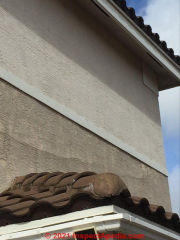 Cristina
Cristina
No one can adequately diagnose the condition of a home's stucco from photos alone, but in one of your photos I think I see a bulge and a horizontal crack in the stucco: suggesting that the stucco bond to the structure has failed or was not properly made in the first place, or there is movement going on (and damage) in the underlying building structure.
I suspect from what I see in your images that this is a synthetic stucco or EIFS type system: stucco applied over solid foam insulating board. The detailing of that installation, particularly at flashings and penetrations is critical for a successful and durable job, as is exact adherence to the instructions of the particular stucco system and product being installed.
An on-site inspector would want to know just what product was installed so as to be able to check the installation against the install-specifications.
I cannot see buckling in your photos: I do see some color variation that often occurs as different parts of the building have different water, sun, wind exposure; paint on stucco (provided it's the proper type of paint approved by the stucco system manufacturer) reduces moisture uptake.
In my OPINON and knowing almost nothing about your building, I'd suggest that you want a clear statement of what problems exist at your home: is this a cosmetic coloring issue or a more-serious issue of leaks into the wall system.
If it is the latter there is risk of costly damage so the cause and cure need to be specified with care.
On 2020-11-12 by Cristina
what could be causing this? can this be caused because I have not painted my house? it was last painted in 2012
Can you tell me why this is happening to my walls what could have caused it. the builder is telling me because I have not painted the house but the house was painted in 2012 aren't homes supposed to be painted every 10 to 12 years. Thank you
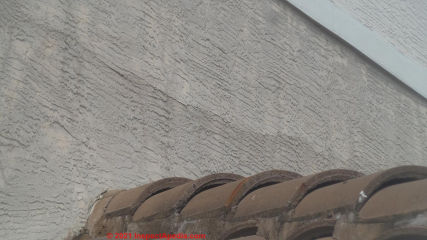
On 2020-09-19 by (mod) - patched stucco cracks now show up as wide flat lines in the surface
Deby
"Fixable" depends. What we are seeing is the smoother texture of the patch material over the stucco cracks.
To hide those you'd need a stucco contractor to skim coat the entire surface with a new, uniform texture.
On 2020-09-19 by Deby
My husband patched cracks in our stucco, it was left to dry for over a week. He applied 1 coat of elastomeric paint and the patches show...is this fixable?
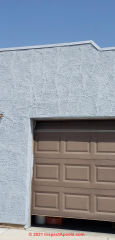
On 2020-07-12 by (mod) - why are there stains on my 5 year old stucco paint job?
Luis
If you're referring to the darker tan stains on the post face at the outside of the balcony and stairs, that looks to me like the effect of water running in or down the exterior surface
On 2020-07-11 by Luis
Can you give me an idea on what could cause these stains to come up on the surface after 5 years of repaint?
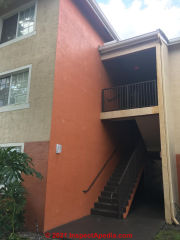
On 2019-12-08 by (mod) - patched stucco cracks have cracked again
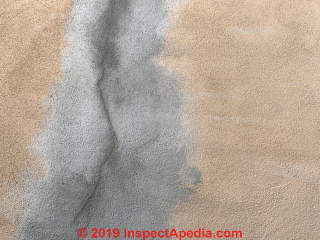 Well IMO, Nicholas, "Bad" is going to provoke some argument. What I see and suspect in your photo are in my OPINION (I'm not a world-leading stucco expert)
Well IMO, Nicholas, "Bad" is going to provoke some argument. What I see and suspect in your photo are in my OPINION (I'm not a world-leading stucco expert)
1. A patch that didn't work: the crack that was previously patched has cracked again;
that suggests either
that there is ongoing movement or stress in the stucco skin so that even a good patch is going to crack again (in that case you need to cut a control joint nearby, then patch the crack again)
or
the patch material itself was not properly mixed or applied and has shrunk and crackes.
2. Stucco crack leaks: Depending on the complete set of construction materials and made more- or -less urgent by the country, city, climate of this stucco exterior, cracks in a stucco exterior are not just cosmetic;
there is a more serious concern with water entry into the wall system, risking further stucco damage, water entry into the wall, and possible rot or insect attack damage.
On 2019-12-08 by Nicholas
Hi Dan & experts,
These areas were recently stucco patched by a contractor. Two weeks later, it rained and many of the areas look like this. Is this bad? Thank you for looking. [Photo shown above - Ed]
On 2019-11-27 by (mod) -
Looks like a filler compound that shrunk.
On 2019-11-27 by Sol
Hey everyone
Wondering if anyone knows why is it that in many areas where the painter patched up my exterior stucco, it’s starts to stick out and then opens in the middle
On 2019-09-17 by (mod) -
I agree that an on-site expert is what's needed and appropriate; for other readers, a paint inspection is needed in San Mateo County, California
You can also post photos (1 per comment) that may invite some feedback;
If there are issues about your paint job, notes about the age of the home, location, weather during the paint job, painting sequence, prep, primer, finish coat, can help explain what one sees on the building.
On 2019-09-17 by Gary Andreacchi
Need a referral for a second opinion on our already newly painted stucco condominium paint job. We are located in the 94010 zip code
On 2018-05-04 by (mod) -
No, C.
There is little chance that the wall surfaces would be sufficiently dry for a successful paint job.
On 2018-04-28 by C
I’m wondering if in your opinion power washing, stucco, wood siding, trim, and windows and painting the same day is an acceptable prep method.
Furthermore they left the window and surface plastic tarps over the wet surface up to the bottom of the exterior walls in my patio for 2 days in 65 dress sunny weather. At the time I kept thinking it would grow mold, but I’m not the expert. Finally I’m emailing pictures to show what I believe are signs they painted over wet stucco and tried to fill wet voids and cracks with paint instead of the correct way. There are a multitude locations I believe there’s now mold growing inside due to the very wet walls, and power washing of the voids.
Note I did pull the molding off one area where the exterior corner has a viable crack they tired to fill with paint so much that it ran inside my walls, there’s obvious moisture and wet drywall, but the molding nails are either not rusted or only a bit rusted at the ends.
The molding shows no signs of direct water damage, but the flashing and wall nails are rautwdb they painted About a month ago. I believe they were totally incompetent, but I know nothing about construction. Considering the images, what is your opinion? Did they really botch this job?
On 2017-12-03 1 by Anonymous
I know the paint I have used is from Sherwin Williams, this is where the builder got the original paint. I also know that it was an elastoicmeric paint they used. Is that what you are talking about?
On 2017-12-02 by (mod) -
I have had good luck sealing against paint bleed through by using a lacquer based primer sealer.
But before using such a sealer on an exterior stucco I would call and talk with the technical support at the paint Manufacturing Company of the paint that I want to use. It may be the recommended alkyd based primer instead.
On 2017-12-02 by Leslie
I live in western Colorado, my house was build in 2006 winter/spring time. The builder when stuccoing the house did the wrong color.
They did an ugly burnt orange color and we chose a dark chocolate brown color. We spoke with the builder immediately and they repainted within a few days. We have had to repaint parts of the house 3 times because the old color continues to seep through. How do I repair this issue so it is not ongoing? Please help!
On 2017-09-26 0 by (mod) -
Mike,
To have room to publish comments and links to appropriate articles supporting my reply, please see your question and our answer at
STUCCO & CONCRETE BONDING AGENTS - use of bonding agents with stucco and concrete coatings & surfaces
On 2017-09-26 1 by Mike Bell
I have a question. I recently hired a stucco contractor to patch a couple of fairly large areas on the exterior of our home where windows were removed and "walled in".
They applied a single layer of traditional stucco, about 3/4" thick, followed a short time later the sme day by a blue-colored bonding agent and then, after about an hour, a finish layer of acrylic stucco. Is this approach ok? Will the traditional stucco cure properly behind the acrylic layer and, if so, how long should I wait before priming and painting with an elastomeric paint? Thank you.
...
Continue reading at PAINTING SHORTCUT ERRORS or select a topic from the closely-related articles below, or see the complete ARTICLE INDEX.
Or see PAINT on STUCCO FAILURE FAQs - questions & answers posted originally at this article
Or see these
Paint Failure Indicator Articles
- PAINT FAILURE, DIAGNOSIS, CURE, PREVENTION - home
- PAINT FAILURE DICTIONARY for terms & examples of all types of paint failures, stains, cracks, gripes.
- PAINT FAILURE INDICATORS
- STAINS on STONE, STUCCO DIAGNOSE & CURE
- STUCCO & CONCRETE BONDING AGENTS - use of bonding agents with stucco and concrete coatings & surfaces
- STUCCO OVER FOAM INSULATION
Suggested citation for this web page
PAINT on STUCCO, FAILURE at InspectApedia.com - online encyclopedia of building & environmental inspection, testing, diagnosis, repair, & problem prevention advice.
Or see this
INDEX to RELATED ARTICLES: ARTICLE INDEX to PAINTS & STAINS & FAILURES
Or use the SEARCH BOX found below to Ask a Question or Search InspectApedia
Ask a Question or Search InspectApedia
Try the search box just below, or if you prefer, post a question or comment in the Comments box below and we will respond promptly.
Search the InspectApedia website
Note: appearance of your Comment below may be delayed: if your comment contains an image, photograph, web link, or text that looks to the software as if it might be a web link, your posting will appear after it has been approved by a moderator. Apologies for the delay.
Only one image can be added per comment but you can post as many comments, and therefore images, as you like.
You will not receive a notification when a response to your question has been posted.
Please bookmark this page to make it easy for you to check back for our response.
IF above you see "Comment Form is loading comments..." then COMMENT BOX - countable.ca / bawkbox.com IS NOT WORKING.
In any case you are welcome to send an email directly to us at InspectApedia.com at editor@inspectApedia.com
We'll reply to you directly. Please help us help you by noting, in your email, the URL of the InspectApedia page where you wanted to comment.
Citations & References
In addition to any citations in the article above, a full list is available on request.
- [1] Quotes in the opening text of this document are from the encyclopedic but not quite complete paint website: PPG Exterior Failures http://www.ppg.com/getpaint/etraining/solver/exterior.html
- [2] Dunn-Edwards Corporation, producer of Dunn-Edwards paints, 4885 E. 52nd Place, Los Angeles CA 90040 (888) DEPAINT dunnedwards.com, provides information sheets for each of their paint products, such as this guide for using Dunn-Edwards Acri-Hues Exterior Acrylic Flat Paint W720 - Quoting from the company's advice on surface preparation to avoid staining problems when painting stucco
All surfaces must be cured, clean, dry, and free from dirt, dust, rust, stains, grease, oil, mildew, wax, efflorescence and other contaminants. Remove all loose, peeling, or chalky paint by sanding, scraping, high-pressure washing or other appropriate methods. Repair all cracks, holes, and other surface imperfections with a suitable patching material. Repaired surfaces should match the surrounding surface texture. If efflorescence exists, remove all noticeable deposits and prime the entire surface with Super-Loc® (W 718), Eff-Stop® (W 709) or Acri-Loc® (W 6232).
- [3] KTA-Tator, Inc.,
Corporate Headquarters,
115 Technology Drive,
Pittsburgh, PA 15275,
: 412.788.1300
Fax: 412.788.1306 E-mail: info@kta.com KTA is a Consulting/Engineering firm founded in 1949 in Pittsburgh, Pennsylvania. Their main specialty is consulting and inspection in the protective coatings and construction industries. - [4] Painting New Stucco - Combating the Problems, at Scott Paint, a Florida company discusses stucco efflorescence cause and prevention
- Painting Contractor Newsletter on Alkalinity and Efflorescence in New Stucco, The Paint Quality Institute, in which the authors point out that high pH and efflorescence correlate. This article suggests that the painter should use a water-based primer/sealer, (Scott Paint recommends an acrylic stucco primer) then use an alkaline resistant 100% acrylic latex top coat, avoid bright colors, and apply two top coats to be sure that cracks and pinholes are sealed. The Paint Quality Institute is at PO Box 904, Spring House PA 19477. www.paintquality.com
- [5] Paint and Surface Coatings, Theory and Practice, R. Lambourne & T.A. Strivens, Ed., Woodhead Publishing Ltd., William Andrew Publishing, 1999 ISBN 1-85573-348 X & 1-884207-73-1 [This is perhaps the leading reference on modern paints and coatings, but is a difficult text to obtain, and is a bit short on field investigation methods - DF]
- [6] Steve Bliss's Building Advisor at buildingadvisor.com helps homeowners & contractors plan & complete successful building & remodeling projects: buying land, site work, building design, cost estimating, materials & components, & project management through complete construction. Email: info@buildingadvisor.com
Steven Bliss served as editorial director and co-publisher of The Journal of Light Construction for 16 years and previously as building technology editor for Progressive Builder and Solar Age magazines. He worked in the building trades as a carpenter and design/build contractor for more than ten years and holds a masters degree from the Harvard Graduate School of Education. Excerpts from his recent book, Best Practices Guide to Residential Construction, Wiley (November 18, 2005) ISBN-10: 0471648361, ISBN-13: 978-0471648369, appear throughout this website, with permission and courtesy of Wiley & Sons. Best Practices Guide is available from the publisher, J. Wiley & Sons, and also at Amazon.com - [7] WHY HOUSE PAINT FAILS, [PDF] Mark Knaebe, US FPL, web search August 2010, original source: http://www.fpl.fs.fed.us/documnts/finlines/knaeb95a.pdf
- [8] WHY PAINT JOBS FAIL [on file as /exterior/Why_Paint_Fails_Bennett.pdf ] - , web search, August 2010, original source: http://www.bennette.com/pdf/whyfail.pdf, four pages describing alligatoring, bleeding, blistering, etc. Bennette Corporation, P.O. Box 9088, Hampton, VA 23670, Phone: 757-838-7777, Toll Free: 800-869-2929
Fax: 757-827-0529, Email: info@bennette.com, Website: www.bennette.com [Dead link 2019/12/13] quoting:
Bennette Paint Manufacturing Company, Inc. is a Virginia corporation which was founded in Newport News, Virginia in 1966 by James P. Bennette, Sr. In 1984, Mr Bennette sold the company to his employees through an Employee Stock Ownership Plan (ESOP). Today the company has a modern manufacturing plant, research laboratory, central warehouse and general offices located at 401 Industry Drive, Hampton, Virginia. From these facilities the company is able to supply quality paints and coatings through its company owned distribution and service centers and authorized dealers located in Virginia, North Carolina and South Carolina. Bennette Paint Manufacturing Company, Inc. also owns and operates Bennette Equipment Company which specializes in the sale, service, and rental of paint spraying and pressure cleaning equipment. - [9] Supplemental Guidelines for Removing Paint From Interior and Exterior Wood Surfaces [on file as "/exterior/Paint_Removal_USGSA.pdf ] - , US General Services Administration, Historical Preservation Technical Procedures, 06400-02, web search August 2010, original source: //w3.gsa.gov/web/p/Hptp.nsf/0/40aff5a115b6a9e5852565c50054b4f4?OpenDocument
- [10] "Common Paint Problems," parkerpaint.com/Common%20Paint%20Problems.htmlparkerpaint.com/Common%20Paint%20Problems.html illustrates common paint failures - though their images and text appear to have been stolen from PPG -whose own original page www.ppg.com/getpaint/etraining/solver/exterior.html was DOA as of 2019/12/13 which catalogs paint failures and causes
- [11] "Paint problem solver" from Lowes unfortunately abandoned and removed from their site as of 2019/12/13
- [12] MILL GLAZE, MYTH or REALITY [PDF], R. Sam Williams, Mark Knaebe, US FPL, retrieved 2019/12/13 original source: fpl.fs.fed.us/documnts/finlines/willi01a.pdf
- [13] paintlab.com is a lab offering paint chip failure analysis
- [14] PPG Exterior Failures http://www.ppg.com/getpaint/etraining/solver/exterior.html
- [15] "Staining and Microbiological Infestation of Acrylic Paintings on Hardboard", Ulrik Runeberg, Conservator (Dipl. Rest./M.A.), Museo de Arte Contemporáneo de Puerto Rico, San Juan Presented,April 2007 conference in Richmond Virginia, sponsored by the AIC (American Institute for Conservation), this paper discussed the staining and microbial infestation of acrylic paintings on hardboard. - private correspondence, ER <->DF 12 September 2006.
- [16] Thanks to reader Christa for discussing white staining on an exterior stucco wall and for providing paint stain failure photographs. May 2010
- [17] Wall Systems, 217 Kinley Ave., NW, Albuquerque, NM 87102 Tel: (505) 242-WALL (9255) and Wall Systems, Inc., 5000 E. Nebraska, Tucson, AZ 87706, Tel: (505) 574-2379 - a Stucco & Sto-Wall contractor has provided contact information for readers needing services in the Southwest: Tel: 505-242-WALL. Website: http://www.albuquerquestucco.com/
- Analysis of Modern Paints, Thomas J.S. Learner, Research in Conservation, 2004 ISBN 0-89236-779-2 [Chemistry of modern paints, overview of analytical methods, pyrolysis-gas chromatography signatures of basic modern paints and their constituents, Fourier transform infrared spectroscopy for paint analysis, direct temperature-resolved mass spectrometry, and analysis in practice - technical reference useful for forensic paint science, focused on art works -DF]
- Art, Biology, and Conservation: Biodeterioration in Works of Art, Robert J. Koestler et als. Eds., Metropolitan Museum of Art, 2003, ISBN 1-58839-107-8
- Best Practices Guide to Residential Construction, by Steven Bliss. John Wiley & Sons, 2006. ISBN-10: 0471648361, ISBN-13: 978-0471648369, Hardcover: 320 pages, available from Amazon.com and also Wiley.com. See our book review of this publication.
- Building Pathology, Deterioration, Diagnostics, and Intervention, Samuel Y. Harris, P.E., AIA, Esq., ISBN 0-471-33172-4, John Wiley & Sons, 2001 [General building science-DF - ** Particularly useful text **
- Dampness in buildings, Diagnosis, Treatment, Instruments, T.A. Oxley & E.G. Gobert, ISBN 0-408-01463-6, Butterworths, 1983-1987 [General building science-DF]
- Paint and Surface Coatings, Theory and Practice, R. Lambourne & T.A. Strivens, Ed., Woodhead Publishing Ltd., William Andrew Publishing, 1999 ISBN 1-85573-348 X & 1-884207-73-1 [This is perhaps the leading reference on modern paints and coatings, but is a difficult text to obtain, and is a bit short on field investigation methods - DF]
- Paint Handbook: testing, selection, application, troubleshooting, surface preparation, etc., Guy E. Weismantel, Ed., McGraw Hill Book Company, 1981, ISBN-10: 0070690618, ISBN-13: 978-0070690615, [Excellent but a bit obsolete paint theory and practice, also a bit light on field investigation methods, out of print, available used-DF]
How to select and apply the right paint or coating for any surface. The first major reference to help you choose the correct paint or other finish to do the job best on a particular surface exposed to a particular environment. Experts in the field give full advice on testing surface preparation, application, corrosion prevention, and troubleshooting. The handbook covers wood, metal, composites, and masonry, as well as marine applications and roof coatings. A ``must'' working tool for contractors, architects, engineers, specification writers, and paint dealers. - Paint and Surface Coatings, Theory and Practice, R. Lambourne & T.A. Strivens, Ed., Woodhead Publishing Ltd., William Andrew Publishing, 1999 ISBN 1-85573-348 X & 1-884207-73-1 [This is perhaps the leading reference on modern paints and coatings, but is a difficult text to obtain, and is a bit short on field investigation methods - DF]
Provides a comprehensive reference source for all those in the paint industry, paint manufacturers and raw materials suppliers, undergraduate and postgraduate students, and industrial paint users. R. Lambourne was in the Research Department at ICI Paints Division and the Industrial Colloid Advisory Group, Birstol University, UK. - Seeing Through Paintings, Physical Examination in Art Historical Studies, Andrea Kirsh, Rustin S. Levenson, Materials in Fine Arts, 2000 ISBN 99-051835 [ forensic science, technical reference, focused on art works - DF]
- Sealants, Durability of Building Sealants (RILEM Proceedings), J.C. Beech, A.T. Wolf, Spon Press; illustrated edition (1995), ISBN-10: 0419210709, ISBN-13: 978-0419210702
This book presents the papers given at the RILEM Seminar held at the Building Research Establishment, Garston, UK in October 1994. The book provides an opportunity for researchers to review up-to-date progress towards the achievement of the objectives of the standardisation of laboratory techniques of sealants in the variety of service conditions to which they are exposed. - Soiling and Cleaning of Building Facades (RILEM Report), L.G.W. Verhoef (Editor), Routledge; 1 edition (November 3, 1988), ISBN-10: 0412306700, USBN-13: 978-0412306709
The report of a comprehensive investigation by RILEM which examines all aspects of the cleaning of facades, subject to soiling by both biological and non-biological agencies. The contributors are international authorities working in this field giving essential advice to all those who need to know how to approach the problems connected with the soiling and cleaning of building facades. - Staining, Prevention of Premature Staining in New buildings, Phil Parnham, Taylor & Francis; 1996, ISBN-10: 0419171304, ISBN-13: 978-0419171300
The appearance of ugly staining early in a buildings life, ruins an otherwise pleasing appearance, tarnishes the image of the owners and gives rise to costly refurbishment works. In this book Phil Parnham raises a number of questions that should be considered whenever a new building is being designed or built. These are: * why has staining become so prominent; * what causes premature staining; which parts of new buildings are likely to be affected; * how can it be avoided? By using a number of highly illustrated case studies, the author answers these questions and ends by suggesting measures that should be taken by all design and construction professionals to prevent premature staining. - Understanding Ventilation, John Bower, The Healthy House Institute, ISBN 0-9637156-5-8, 1995 [General building science-DF - ** Particularly useful text. Mr. Bower has retired from the field but his book continues to be important]
- "Moisture Control in buildings: Putting Building Science in Green Building," Alex Wilson, Environmental Building News, Vol. 12. No. 5. [Good tutorial, "Moisture 101" outlining the physics of moisture movement in buildings and a good but incomplete list of general suggestions for moisture control - inadequate attention given to exterior conditions such as roof and surface drainage defects which are among the most-common sources of building moisture and water entry.--DJF]
- In addition to citations & references found in this article, see the research citations given at the end of the related articles found at our suggested
CONTINUE READING or RECOMMENDED ARTICLES.
Paint & Fiber Forensic Analysis, Diagnosis, Conservation
- Analysis of Modern Paints, Thomas J.S. Learner, Research in Conservation, 2004 ISBN 0-89236-779-2
[Chemistry of modern paints, overview of analytical methods, pyrolysis-gas chromatography signatures of basic modern paints and their constituents, Fourier transform infrared spectroscopy for paint analysis, direct temperature-resolved mass spectrometry, and analysis in practice - technical reference useful for forensic paint science, focused on art works. One of our most useful texts in forensic investigation of paint failures and paint problem diagnosis - for building investigators as well as art conservators. -DF]
Although oil remains an important binding medium in artists' paints, today's synthetic resins are being used with increasing frequency. This was true during much of the twentieth century, when artists such as David Alfaro Siqueiros, Jackson Pollock, and Pablo Picasso used commercial or industrial paints based on synthetic resins. The growing popularity of synthetic resin materials carries important implications for the conservation, preservation, and treatment of modern art.
This volume outlines the techniques that are currently employed to analyze the synthetic resins used in modern painting materials, such as pyrolysis-gas chromatography-mass spectrometry, Fourier Transform infrared spectroscopy, and direct temperature-resolved mass spectrometry. For each technique, results are given for standard samples of the principal classes of synthetic binding media, various pigments and extenders, tube paint formulations, and microscopic paint fragments taken from actual works of art.
Primarily intended for conservation scientists, conservators, researchers, and students of conservation, this book will also be of interest to other museum professionals. - Exterior Paint Problems on Historic Woodwork [Copy on file as /exterior/Preservation_Brief_10_ Exterior_Paint_Problems_on_Historic_Woodwork.pdf ] - , Kay D. Weeks and David W. Look, AIA, U.S. Department of the Interior, National Parks Service Preservation Brief No. 10. Web search 02/01/2011, original source: http://www.nps.gov/hps/tps/briefs/brief10.htm
- Microscopy of Textile Fibres (Microscopy Handbooks, 32), P H Greaves, Garland Science; 1 edition (January 1, 1995), ISBN-10: 1872748244, ISBN-13: 978-1872748245
[We ordered our copy from the British publisher - now it's on Amazon.
These 3 fiber books have been essential forensic lab references supplementing our McCrone Research courses on forensic microscopy; also of use to textile conservators. - DF
An up-to-date practical guide to the properties and characteristics of textile fibres, with clear advice on sampling, specimen preparation and examination procedures. - Modern Paints Uncovered (Getty Conservation Institute Symposium Proceedings), Thomas Learner, Getty Publications (March 1, 2008),ISBN-10: 089236906X, ISBN-13: 978-0892369065
Over the past seventy years, a staggering array of new pigments and binders has been developed and used in the production of paint, and twentieth-century artists readily applied these materials to their canvases. Paints intended for houses, boats, cars, and other industrial applications frequently turn up in modern art collections, posing new challenges for paintings conservators.
This volume presents the papers and posters from "Modern Paints Uncovered," a symposium organized by the Getty Conservation Institute, Tate, and the National Gallery of Art and held at Tate Modern, London, in May 2006. Professionals from around the world shared the results of research on paints that have been available to artists since 1930--the date that synthetic materials began to significantly impact the paint industry.
Modern Paints Uncovered showcases the varied strands of cutting-edge research into the conservation of contemporary painted surfaces. These include paint properties and surface characteristics, analysis and identification - Of Microbes and Art: The Role of Microbial Communities in the Degradation and Protection of Cultural Heritage, Kindle Edition, Springer; 1 edition (June 30, 2000), ASIN: B000VHV4FC
- Paint Handbook: testing, selection, application, troubleshooting, surface preparation, etc., Guy E. Weismantel, Ed., McGraw Hill Book Company, 1981
[Excellent but a bit obsolete paint theory and practice, also a bit light on field investigation methods, out of print, available used. Very useful reference for paint testing, selection, and paint failure diagnosis - focus on non-artistic use of paints such as on buildings, roofs, marine coatings. -DF]
How to select and apply the right paint or coating for any surface. The first major reference to help you choose the correct paint or other finish to do the job best on a particular surface exposed to a particular environment. Experts in the field give full advice on testing surface preparation, application, corrosion prevention, and troubleshooting. The handbook covers wood, metal, composites, and masonry, as well as marine applications and roof coatings. A ``must'' working tool for contractors, architects, engineers, specification writers, and paint dealers - Paint Magic, Jocasta Innes, Frances Lincoln; 4th edition (August 17, 2006), ISBN-10: 071122272X, ISBN-13: 978-0711222724 - Paint advice for home decoration, including painting techniques such as antiquing, bambooing, bleaching, color washing, combing, decorative painting, dragging, dyeing, gliding, graining, japanning, lacquering, lining, marbling, porphyry, rag-rolling, sponging, staining, stencilling, stippling, tortoiseshelling, trompe l'oeil, and vinegar painting - DF
- Paint and Surface Coatings, Theory and Practice, R. Lambourne & T.A. Strivens, Ed., Woodhead Publishing Ltd., William Andrew Publishing, 1999 ISBN 1-85573-348 X & 1-884207-73-1
[ This is perhaps the leading reference on modern paints and coatings, but is a difficult text to obtain, and is a bit short on field investigation methods. Encyclopedic reference on the composition, production, properties, use, and testing of paints and coatings - DF]
Provides a comprehensive reference source for all those in the paint industry, paint manufacturers and raw materials suppliers, undergraduate and postgraduate students, and industrial paint users. - Plant Biology for Cultural Heritage: Biodeterioration and Conservation, Giulia Caneva, Maria Pia Nugari, Ornella Salvadori, Getty Publications (January 15, 2009), ISBN-10: 0892369396, ISBN-13: 978-0892369393
- Quality Assessment of Textile, Karl Marshall, Kindle Edition, Springer; 2nd edition (October 31, 1993, ASIN: B00193F3BI
The damage which can occur in certain fibrous raw materials or during the production and storage of textiles is expertly described in this book by Karl Mahall. He particularly shows how to find concealed textile defects by using microscopic analysis. The examples represent typical cases that the author encountered during forty years of experience in the industry. Well-illustrated with impressive photographs, they invite you to follow each step and learn to apply the same methodology in practice. This book is especially useful as a manual for both chemical and textile engineers and quality engineers. It is also a useful reference for others in the textile industry in general. - Dampness in buildings, Diagnosis, Treatment, Instruments, T.A. Oxley & E.G. Gobert, ISBN 0-408-01463-6, Butterworths, 1983-1987 [General building science-DF]
- "Moisture Control in buildings: Putting Building Science in Green Building," Alex Wilson, Environmental Building News, Vol. 12. No. 5. [Good tutorial, "Moisture 101" outlining the physics of moisture movement in buildings and a good but incomplete list of general suggestions for moisture control - inadequate attention given to exterior conditions such as roof and surface drainage defects which are among the most-common sources of building moisture and water entry.--DJF]
- PAINT FAILURE PROBLEMS AND THEIR CURE [PDF] Daniel L. Cassens and William C. Feist, National Forest Products Laboratory
- WHY HOUSE PAINT FAILS, [PDF] Mark Knaebe, US FPL, web search August 2010, original source: http://www.fpl.fs.fed.us/documnts/finlines/knaeb95a.pdf
- WHY PAINT JOBS FAIL [on file as /exterior/Why_Paint_Fails_Bennett.pdf ] - , web search, August 2010, original source: http://www.bennette.com/pdf/whyfail.pdf, four pages describing alligatoring, bleeding, blistering, etc. Bennette Corporation, P.O. Box 9088, Hampton, VA 23670, Phone: 757-838-7777, Toll Free: 800-869-2929
Fax: 757-827-0529, Email: info@bennette.com, Website: www.bennette.com [Dead link 2019/12/13] quoting:
Bennette Paint Manufacturing Company, Inc. is a Virginia corporation which was founded in Newport News, Virginia in 1966 by James P. Bennette, Sr. In 1984, Mr Bennette sold the company to his employees through an Employee Stock Ownership Plan (ESOP). Today the company has a modern manufacturing plant, research laboratory, central warehouse and general offices located at 401 Industry Drive, Hampton, Virginia. From these facilities the company is able to supply quality paints and coatings through its company owned distribution and service centers and authorized dealers located in Virginia, North Carolina and South Carolina. Bennette Paint Manufacturing Company, Inc. also owns and operates Bennette Equipment Company which specializes in the sale, service, and rental of paint spraying and pressure cleaning equipment. - Supplemental Guidelines for Removing Paint From Interior and Exterior Wood Surfaces [on file as "/exterior/Paint_Removal_USGSA.pdf ] - , US General Services Administration, Historical Preservation Technical Procedures, 06400-02, web search August 2010, original source: //w3.gsa.gov/web/p/Hptp.nsf/0/40aff5a115b6a9e5852565c50054b4f4?OpenDocument
- "Common Paint Problems," parkerpaint.com/Common%20Paint%20Problems.htmlparkerpaint.com/Common%20Paint%20Problems.html illustrates common paint failures - though their images and text appear to have been stolen from PPG -whose own original page www.ppg.com/getpaint/etraining/solver/exterior.html was DOA as of 2019/12/13 which catalogs paint failures and causes
- "Paint problem solver" from Lowes unfortunately abandoned and removed from their site as of 2019/12/13
- MILL GLAZE, MYTH or REALITY [PDF], R. Sam Williams, Mark Knaebe, US FPL, retrieved 2019/12/13 original source: fpl.fs.fed.us/documnts/finlines/willi01a.pdf
- paintlab.com is a lab offering paint chip failure analysis
- PPG Exterior Failures http://www.ppg.com/getpaint/etraining/solver/exterior.html
- "Peeling Back Paint Layers For a Glimpse Into the Past," James Barron, The New York Times, 25 Feb 2010, p. A26
- In addition to citations & references found in this article, see the research citations given at the end of the related articles found at our suggested
CONTINUE READING or RECOMMENDED ARTICLES.
- Carson, Dunlop & Associates Ltd., 120 Carlton Street Suite 407, Toronto ON M5A 4K2. Tel: (416) 964-9415 1-800-268-7070 Email: info@carsondunlop.com. Alan Carson is a past president of ASHI, the American Society of Home Inspectors.
Thanks to Alan Carson and Bob Dunlop, for permission for InspectAPedia to use text excerpts from The HOME REFERENCE BOOK - the Encyclopedia of Homes and to use illustrations from The ILLUSTRATED HOME .
Carson Dunlop Associates provides extensive home inspection education and report writing material. In gratitude we provide links to tsome Carson Dunlop Associates products and services.


